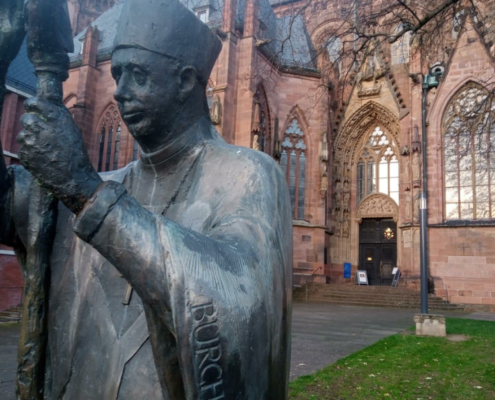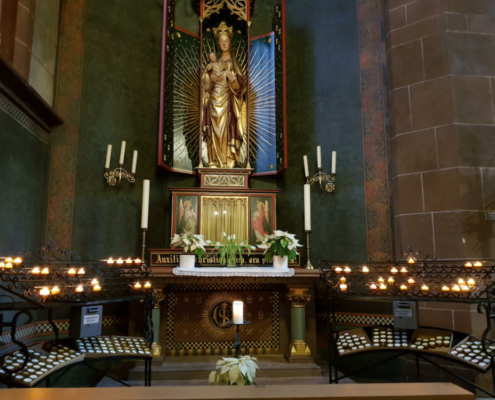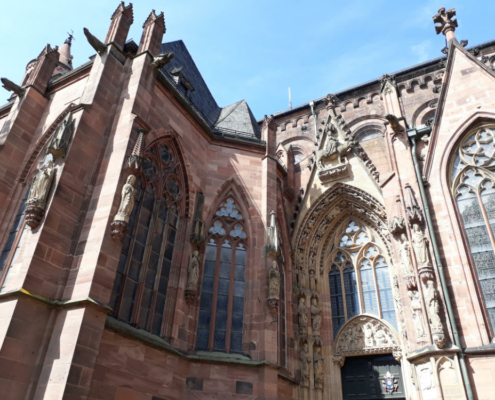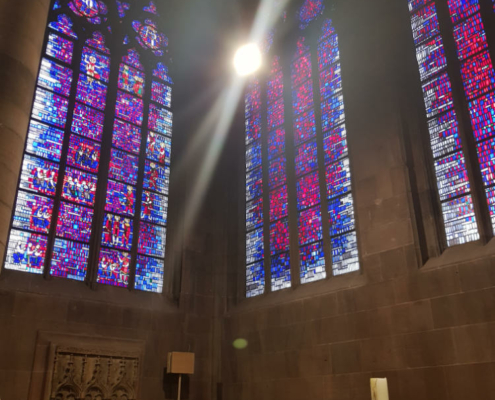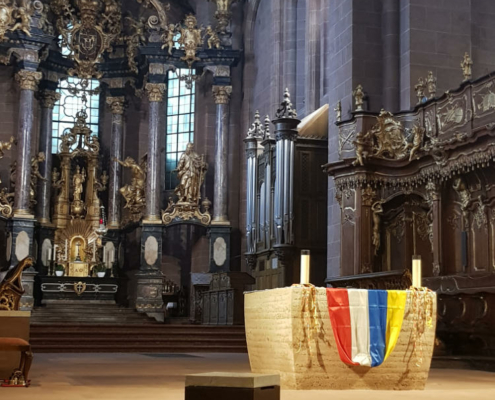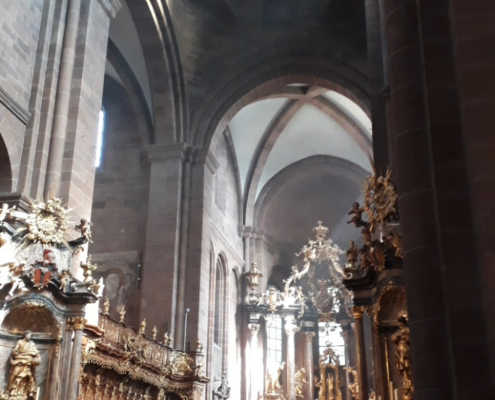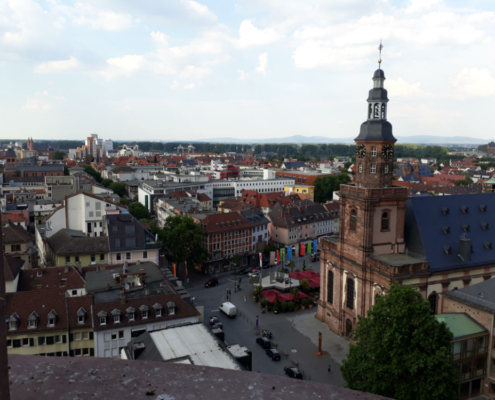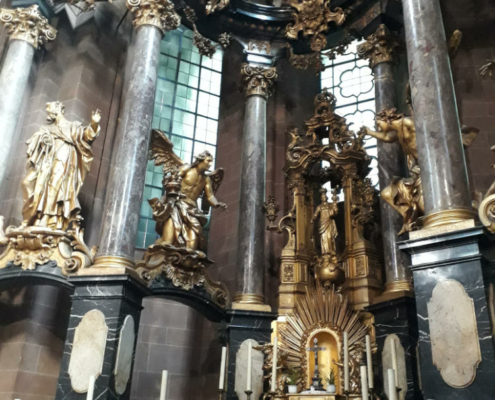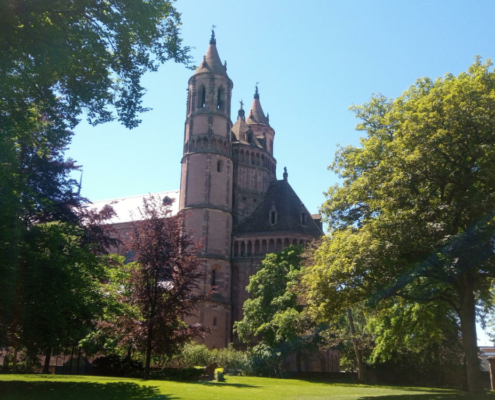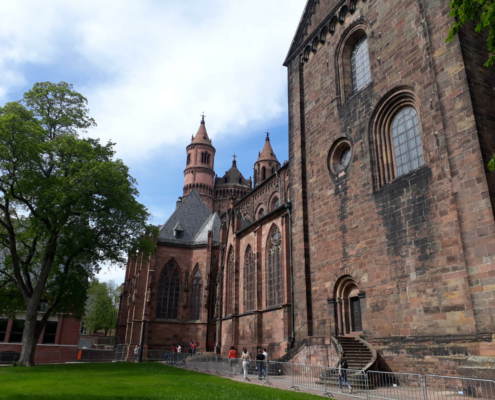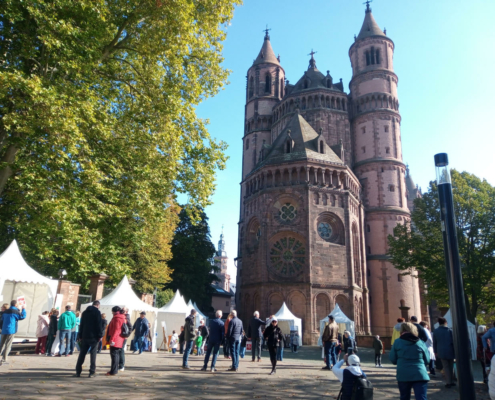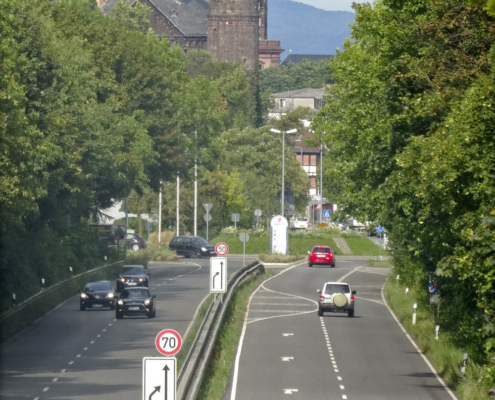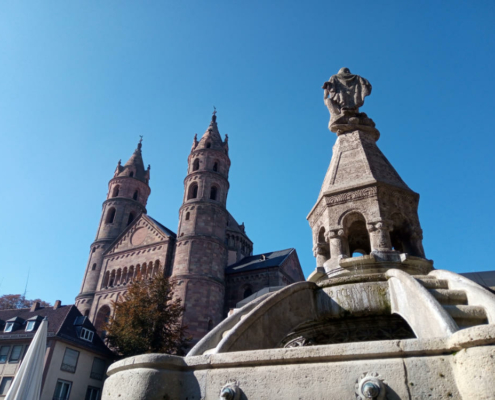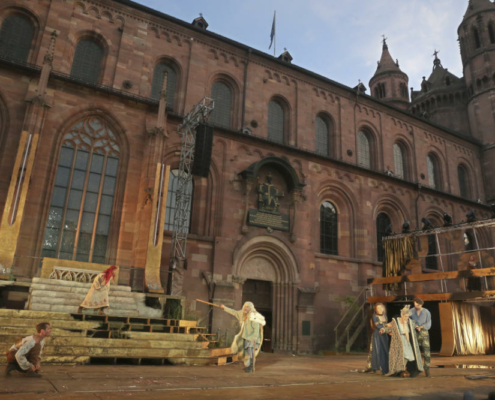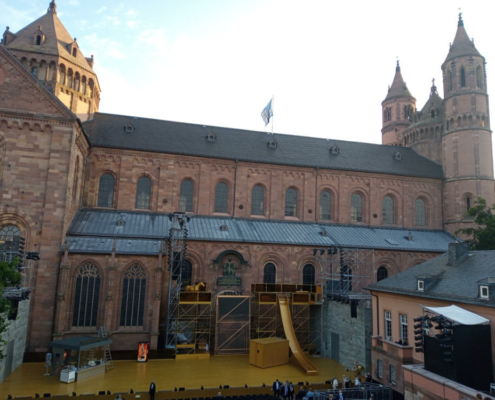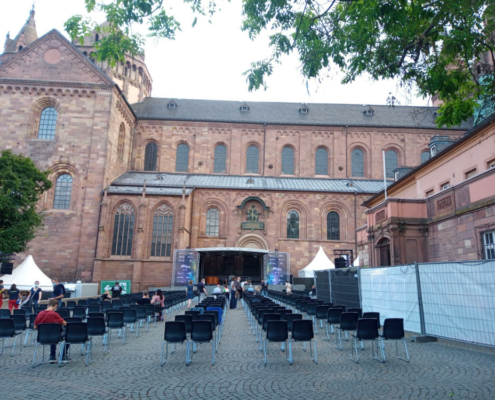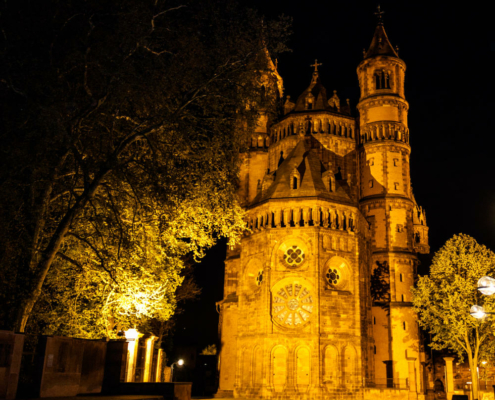Worms Cathedral of St. Peter
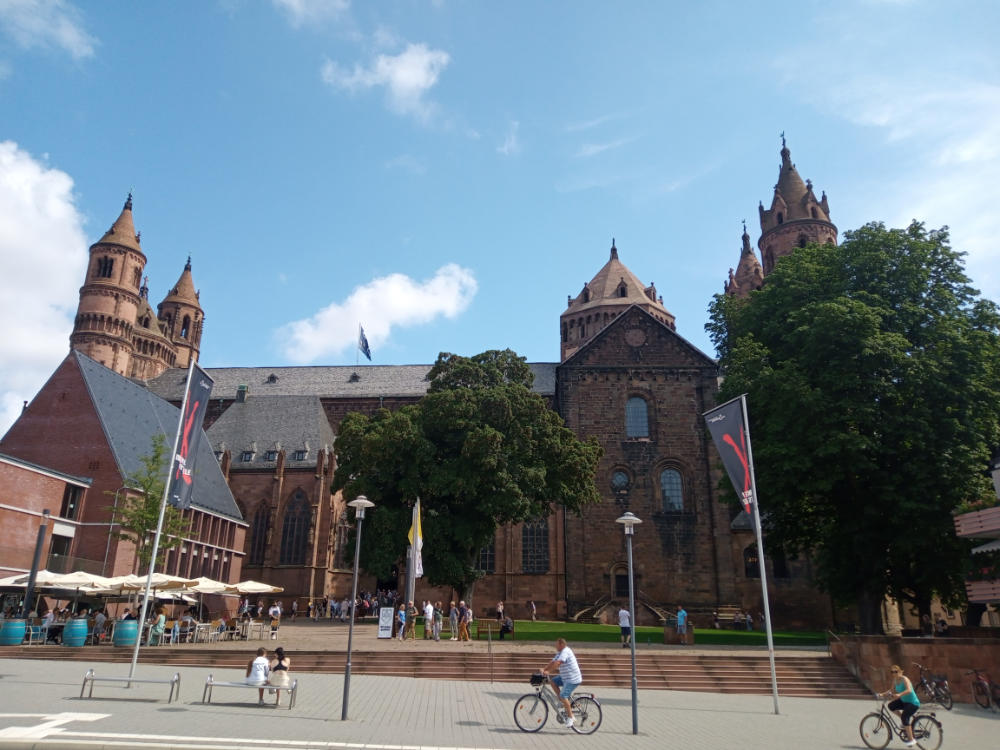 Ein Silent witness to history and THE landmark of the city
Ein Silent witness to history and THE landmark of the city
For quite a few people in Worms, the sight of Worms Cathedral St. Peter from a distance means that you are at home. In fact, the roughly 1,000-year-old building dominates the cityscape when approached from three directions. Only when approaching the city from the north does the cathedral raise its proud head very late. Apart from the height of the building – the eastern towers rise 65 metres – its visual dominance is due to the fact that the cathedral was built on the highest point in the middle of the city. Of course, this is not difficult in a city whose geographical location is just 86 metres above sea level. The decision to build the cathedral on this very spot had less to do with visibility than simply with the fact that it was believed to be protected from flooding. The city centre of Worms is never affected by floods because of its distance from the Rhine. But it was different in the Middle Ages, when the Rhine had not yet been straightened and its many arms meandered right up to the city wall where the Nibelungen Museum now stands.
A place of power and faith for 1000 years
Together with Mainz Cathedral and Speyer Cathedral, it is one of the imperial cathedrals on the Rhine. In total, there are seven imperial cathedrals in Germany. The history of the cathedral is divided into two decades. The first begins with the construction of the original cathedral, i.e. the church commissioned by the influential Bishop Burchard. The second begins with the rebuilding of the same cathedral, only a few hundred years later. In the year 1000, Burchard was appointed Bishop of Worms. He felt that the existing church was neither large enough nor up to date. Without further ado, he had the three-nave basilica demolished. A new church was built in just 15 years. An extremely short period of time for the time. The contours of this “first Worms cathedral” essentially corresponded to the shape of today’s cathedral. Burchard died in 1025, and his successor Burchard II and his successor Conrad II had this building demolished piece by piece a few years later in order to erect a new, more impressive place of worship. In 1181, St. Peter’s Cathedral was finally consecrated in the form in which it is still known today. The proud building, which has a very special architecture in its fusion of Gothic and Romanesque styles, has experienced a varied history since then. Emperors were crowned or married there. The coronation of Pope Leo IX also took place there in 1048. In 1521, the theologian Martin Luther resisted the revocation demanded by the emperor and the pope in the immediate vicinity.
Destruction and construction
The cathedral was destroyed and rebuilt again and again. During the Thirty Years’ War 1618-1648, for example, the cathedral was severely damaged by Swedish troops. French troops also devastated and looted the cathedral during the Palatinate Wars of Conquest in 1688-1697. An attempt to blow up the cathedral failed, but it burned down completely. As a result of the renovation, baroque elements were added to the interior of the Romanesque-Gothic building. In 1792 Worms was once again besieged by French troops. This time, the spacious interior of the cathedral was used as a stable and storehouse. From 1886 to 1995, the cathedral was thoroughly renovated. However, this did not last long. At the end of the Second World War, the cathedral fell victim to an air raid on Worms. Years earlier, the National Socialists had already removed the cathedral bells in order to melt them down for use in weapons. It was only on the occasion of the 1000th anniversary in 2018 that the cathedral received its complete bell ensemble back, thanks to donors from Worms. A total of eight bells, five of which can be traced back to these donations, give the cathedral its unmistakable massive sound. When the bells of the Church of the Holy Trinity and the Magnus Church are added at certain times, a truly impressive bell concert resounds in the city centre of Worms, which has already made it difficult for many artists to perform or granted them a short break.
The Nibelungs and Worms Cathedral
In its eventful history, Worms Cathedral has not only been a setting for bishops, emperors and kings, but also inspired an unknown poet to write an iconic scene in literary history, namely the “Queen’s quarrel” in the world-famous verse epic “Song of the Nibelungs”. If one believes the poet’s lines, the fateful quarrel between Brünhild and Kriemhild took place on the north side of the cathedral at the imperial portal. In essence, it is about the rivalry between the two women over the question of who is more important for the Burgundian kingdom. This conflict erupts as both are on their way to worship. It finally escalates on the steps of the imperial portal. Brünhild, who is married to King Gunther, insults Kriemhild, saying she is an unfree maidservant and wife of a serf, namely Siegfried. Kriemhild finally retorts angrily that it was her husband Siegfried who took Brünhild’s virginity unrecognised on their wedding night. As proof of this, she presents the ring and belt which Siegfried stole from Brünhild’s chambers that night. The consequences of this quarrel are devastating for the staff of this legend. The humiliated husband Gunther decides with his brothers and the faithful Hagen to murder Siegfried. This in turn leads to “Kriemhild’s revenge”, to which almost all the important figures of the Song of the Nibelungs fall victim. Today, between the Siegfried Fountain and the cathedral, there is also a sculpture group that recreates that famous scene. The partly gilded bronze figures, designed by Jens Nettlich, are part of an installation of 14 objects along Nibelungenstrasse and Siegfriedstrasse. The cathedral itself again serves as an impressive backdrop during the Nibelungen Festival. Quite a few visitors and reviewers of the productions see in the historically significant building not only an atmospheric stage set, but also recognise in it a dramaturgical significance, which also demands the necessary respect from one or the other actor to play in the shadow of these mighty walls. Translated with www.DeepL.com/Translator (free version)
The Emperor’s Portal
But Kriemhild and Brünhild are not the only ones who stepped over these significant steps. Immediately in front of the portal was also a courtroom. There, Emperor Frederick I, clearly better known by the epithet Barbarossa, confirmed imperial privileges to the city in the form of city rights in 1184. These were in turn granted in 1074. This was a great honour for the citizens of this city, as it was associated with far-reaching privileges of freedom. Cast in ore, this document was walled in above the portal. Also a victim of the destruction, the Worms artist Gustav Nonnemacher designed an inscription plaque in 1981 to commemorate this momentous occasion, which is enthroned above the imperial portal. Emperor Frederick, who is often associated with Kaiserslautern, had a special relationship with Worms. A city he loved not only because of its special climate. He also married his wife Beatrix of Burgundy in the imperial city of the time. The portal can be reached via the Schlossplatz on the north side. There is also one of the three entrances to the fantastically beautiful Heylshof Park.
The cathedral has gone to the dogs
If you stand in front of the main entrance on the south side and let your gaze wander over the ensemble of figures around the entrance area, you will discover a sculpture that is actually quite atypical as an ornament of a church. Amidst all the dragon heads, which are supposed to keep evil from entering the place of worship, as well as the holy figures, there is a dachshund in the middle of it, looking over the cathedral square with a curious gaze. The cathedral’s master builder Philipp Brandt erected a monument to this dachshund in 1920. The dachshund was Brandt’s constant companion, even when he was working in the cathedral. When Brandt was once again standing on scaffolding, the dachshund suddenly jumped on him and tried to bite Brandt’s leg. The master builder then jumped to the side. Only a few moments later, a piece of rock suddenly crashed down. Thanks to the courageous jump to the side, it missed the man. The dachshund had saved the cathedral’s master builder’s life, and in gratitude he immortalised the dog on the south portal of Worms Cathedral, causing amused faces to this day upon its discovery. At this point, of course, I don’t want to reveal where exactly the dachshund can be found. So I hope all visitors have fun looking for it.
More information on visiting times etc. can be found here:
www.bistummainz.de/pfarrgruppe/worms-dom-st-peter/
Fotos: Dennis Dirigo

